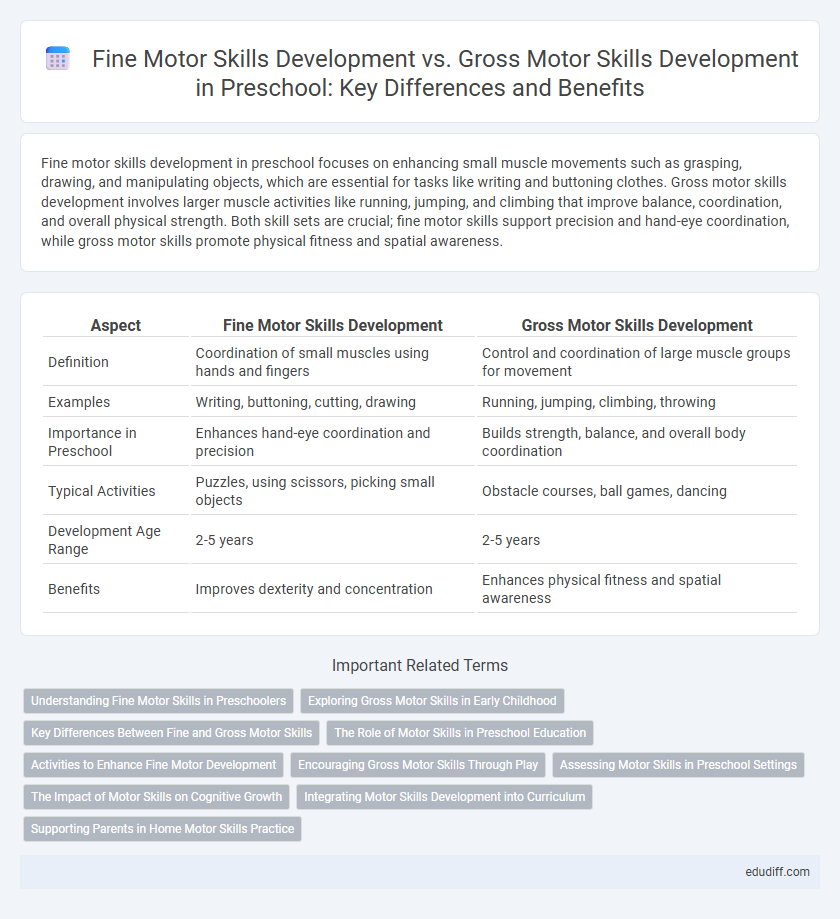Fine motor skills development in preschool focuses on enhancing small muscle movements such as grasping, drawing, and manipulating objects, which are essential for tasks like writing and buttoning clothes. Gross motor skills development involves larger muscle activities like running, jumping, and climbing that improve balance, coordination, and overall physical strength. Both skill sets are crucial; fine motor skills support precision and hand-eye coordination, while gross motor skills promote physical fitness and spatial awareness.
Table of Comparison
| Aspect | Fine Motor Skills Development | Gross Motor Skills Development |
|---|---|---|
| Definition | Coordination of small muscles using hands and fingers | Control and coordination of large muscle groups for movement |
| Examples | Writing, buttoning, cutting, drawing | Running, jumping, climbing, throwing |
| Importance in Preschool | Enhances hand-eye coordination and precision | Builds strength, balance, and overall body coordination |
| Typical Activities | Puzzles, using scissors, picking small objects | Obstacle courses, ball games, dancing |
| Development Age Range | 2-5 years | 2-5 years |
| Benefits | Improves dexterity and concentration | Enhances physical fitness and spatial awareness |
Understanding Fine Motor Skills in Preschoolers
Fine motor skills in preschoolers involve the coordination of small muscles, primarily in the hands and fingers, enabling tasks such as drawing, cutting, and buttoning clothes. Developing these skills supports handwriting readiness and enhances hand-eye coordination, which is crucial for academic success. Targeted activities like puzzles, threading beads, and using scissors foster fine motor development, distinct from gross motor skills that engage larger muscle groups for activities like running or jumping.
Exploring Gross Motor Skills in Early Childhood
Gross motor skills development in early childhood involves the enhancement of large muscle groups responsible for movements such as running, jumping, climbing, and balance. Activities like outdoor play, obstacle courses, and dance contribute significantly to children's coordination, strength, and spatial awareness. Mastery of gross motor skills supports overall physical growth and lays the foundation for complex movements and healthy habits throughout childhood.
Key Differences Between Fine and Gross Motor Skills
Fine motor skills development involves the coordination of small muscles, particularly in the hands and fingers, allowing children to perform tasks such as drawing, buttoning, and manipulating small objects. Gross motor skills development focuses on larger muscle groups responsible for movements like running, jumping, and climbing, which are crucial for overall physical coordination and balance. The key difference lies in the muscle groups targeted and the precision required, with fine motor skills emphasizing dexterity and control, while gross motor skills emphasize strength and large body movements.
The Role of Motor Skills in Preschool Education
Fine motor skills development in preschool involves activities that enhance hand-eye coordination, dexterity, and precise movements such as drawing, cutting, and buttoning, which are essential for writing readiness and daily self-care tasks. Gross motor skills development encompasses large muscle activities like running, jumping, and climbing that promote balance, coordination, and overall physical fitness vital for active play and physical health. Both fine and gross motor skills are crucial in preschool education as they support cognitive growth, social interaction, and the foundation for academic success.
Activities to Enhance Fine Motor Development
Engaging preschoolers in activities such as threading beads, finger painting, and using child-safe scissors significantly enhances fine motor skills development by promoting hand-eye coordination and dexterity. These tasks strengthen small muscles in the hands and fingers, essential for writing and self-care tasks. Consistent practice with puzzles and playdough also supports precision and control, fostering the foundational skills needed for academic success.
Encouraging Gross Motor Skills Through Play
Encouraging gross motor skills through play involves activities that promote whole-body movements such as running, jumping, climbing, and throwing, essential for preschoolers' physical development. Play-based experiences like obstacle courses, ball games, and outdoor exploration enhance balance, coordination, and strength while providing opportunities for social interaction and cognitive growth. Prioritizing these activities supports foundational motor skills crucial for everyday functions and academic readiness.
Assessing Motor Skills in Preschool Settings
Assessing motor skills in preschool settings involves evaluating both fine motor skills, such as precise hand movements and coordination, and gross motor skills, which include larger movements like running, jumping, and balance. Early childhood educators utilize standardized checklists, observational assessments, and developmental milestones to monitor progress in dexterity, hand-eye coordination, muscle strength, and overall body control. Effective assessment ensures targeted interventions that foster physical development critical for school readiness and daily functional activities.
The Impact of Motor Skills on Cognitive Growth
Fine motor skills development, such as grasping and manipulating small objects, enhances neural connections linked to hand-eye coordination and problem-solving abilities in preschool children. Gross motor skills development, including running and jumping, stimulates brain regions responsible for spatial awareness and executive functioning. The combined progression of both motor skills significantly boosts cognitive growth by enabling more complex learning experiences and environmental interactions.
Integrating Motor Skills Development into Curriculum
Integrating fine motor skills development into preschool curriculum enhances children's hand-eye coordination, dexterity, and precision through activities like cutting, drawing, and manipulating small objects. Gross motor skills development is equally vital, promoting balance, coordination, and strength with exercises such as running, jumping, and climbing. A balanced curriculum that incorporates both fine and gross motor activities supports comprehensive physical growth and prepares children for future academic and social success.
Supporting Parents in Home Motor Skills Practice
Supporting parents in home motor skills practice enhances preschoolers' fine motor skills through activities like drawing, buttoning, and using scissors, which improve hand-eye coordination and dexterity. Gross motor skills development benefits from encouraging climbing, jumping, and balancing exercises that strengthen large muscle groups and improve overall body control. Parents play a crucial role by creating a safe, engaging environment and providing age-appropriate tools and guidance to foster consistent motor skills growth.
Fine Motor Skills Development vs Gross Motor Skills Development Infographic

 edudiff.com
edudiff.com